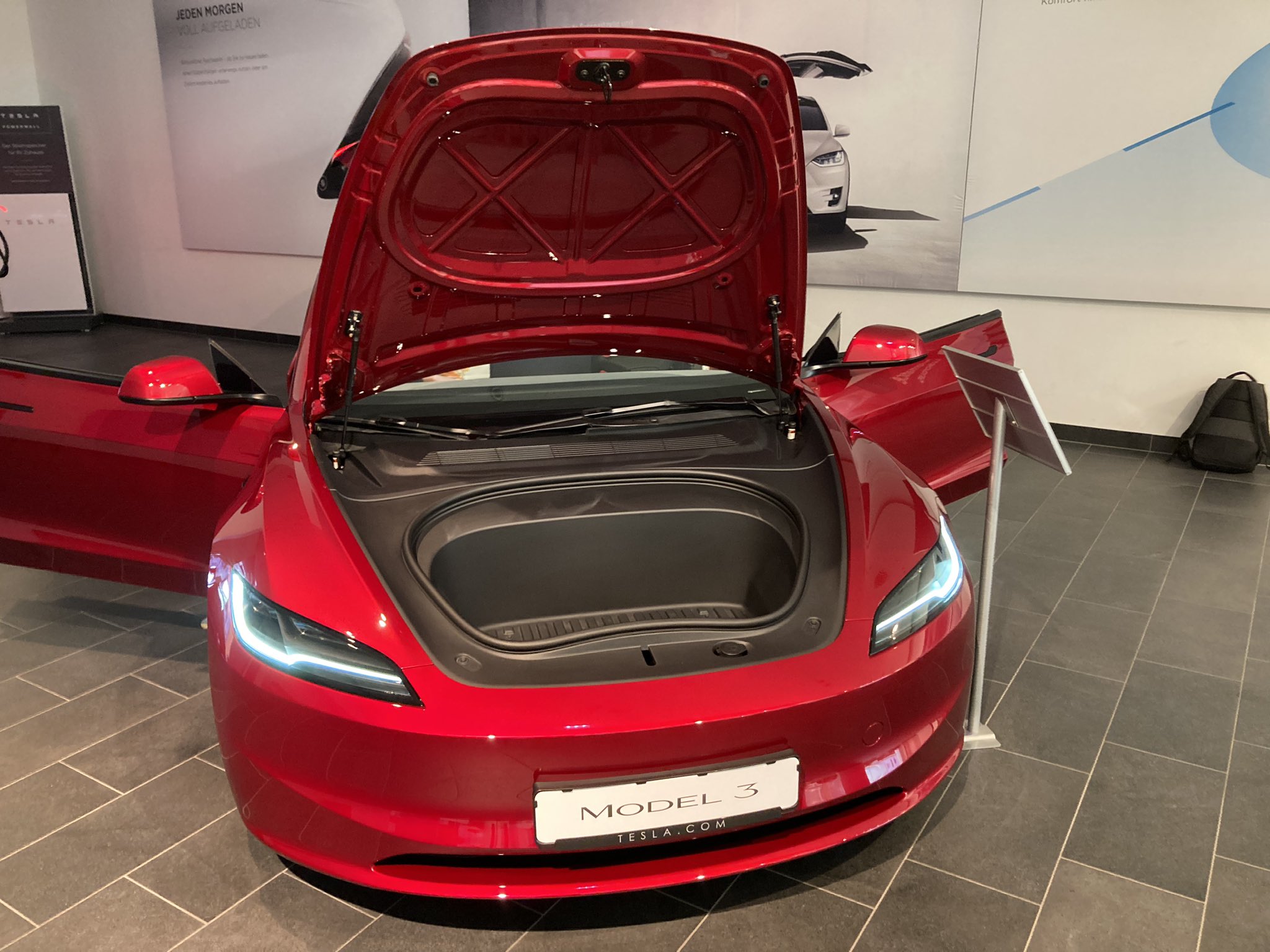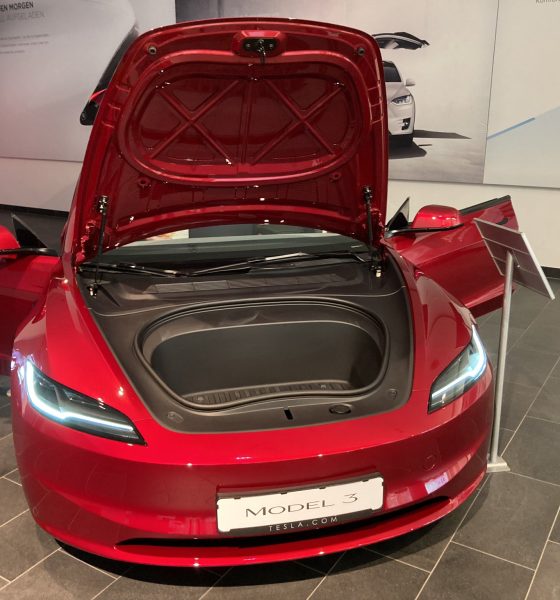Update: Pre-2024 Model 3 trunk specs added on 9/16/23.
The Tesla Model 3 Highland has been making headlines in the past several weeks, as many have been able to take their first looks at the refreshed vehicle. Ahead of initial deliveries, some specifications for the refreshed Model 3 have surfaced — most recently including measurements for the frunk and trunk.
X user @DerCaspar shared photos of the Model 3 Highland on display at the Mall of Berlin on Friday, along with measurements for the newly redesigned vehicle’s frunk and trunk. Additionally, Caspar shared details about the sub-trunk, the small space beneath the floor of the trunk.
Check out the trunk, sub-trunk and frunk measurements below, according to Caspar:
Tesla Model 3 Highland trunk
– back row up 107 cm (~42.1 inches)
– back row down till seat 187 cm (~73.6 inches)
– back row down till seat moved 210 cm (~82.7 inches)
– back row down till front screen 270 cm (~106.3 inches)
– width between wheel covers 94 cm (~37 inches)
– width between back row hand bars 129.5 cm (~51 inches)
– height trunk opening 46 cm (~18.1 inches)
Tesla Model 3 Highland sub-trunk
– height till sub-trunk cover 29 cm (~11.4 inches)
– narrowest width 63 cm (~24.8 inches)
– narrowest depth 32 cm (~12.6 inches)
Tesla Model 3 Highland frunk
– frunk height 23 cm (~9.1 inches)
– frunk width 72 cm (~28.3 inches)
– frunk depth 35 cm (~13.8 inches)
You can see Caspar’s full thread on X below, where he details his initial impressions of the Model 3 Highland.
Tesla Model 3 Highland
I am seeing it first hand for the first time and will post measurements during the next hour as go through the car – it looks and feels awesome 🤩
Come along pic.twitter.com/d1lXQT1T3v
— Caspar – creating a positive future ✨ (@CasparThomale) September 15, 2023
Caspar also updated the thread with a German forum showing the pre-Highland Model 3’s trunk, sub-trunk and frunk dimensions. It’s worth noting that the measurements aren’t all taken the exact same way. As one example, Caspar measured the sub-trunk width and depth at its narrowest points, while the forum user measured the old Model 3’s depth at its deepest point.
Still, comparing the two sets of dimensions can provide a pretty good comparison point for the refreshed Highland Model 3.
You can head to the forum to see pictures showing how each dimension was measured.
Pre-2024 Tesla Model 3 (non-Highland) trunk
– back row up 107 cm (~42.1 inches)
– back row down till seat 190 cm (~74.8 inches)
– back row down till seat moved completely forward 206 cm (~81.1 inches)
– width between wheel covers 94 cm (~37 inches)
– height trunk opening 46 cm (~18.1 inches)
Pre-2024 Tesla Model 3 (non-Highland) sub-trunk
– height 30 cm (~11.8 inches)
– deepest depth 46 cm (~18.1 inches)
– width 61 cm (~24 inches)
Pre-2024 Tesla Model 3 (non-Highland) frunk
– frunk height 20 cm (~7.9 inches)
– frunk depth 38 cm (~15 inches)
– frunk width at 71 cm (~28 inches)
Other features in the Tesla Model 3 Highland
In addition to providing measurements for the trunk, sub-trunk and frunk spaces, Caspar later noted a few of his favorite features in the Model 3 Highland. These included the infotainment screen in the back row, the updated headlights and general Model S-like exterior appearance, and the car’s upgraded sound dampening.
He also notes the ability to control climate and seat heating separately for the right and left rear passengers and the customizable ambient lighting strip across the front interior of the car as impressive updates. Later in the thread, a few users also pointed out that the rear fog lights flash when the trunk is opened, which is another new feature for the refreshed Model 3. When asked if he was able to try the new ventilated seats, Caspar said he hasn’t, though he plans to.
In recent weeks, users have also pointed out the Model 3 Highland’s new features, such as Auto-Shift out of Park, updated airbag placement, a blindspot indicator and several other upgrades. Earlier this week, the Model 3 Highland’s size was also revealed after the vehicle was officially registered with the China Ministry of Industry and Information Technology.
What are your thoughts? Let me know at zach@teslarati.com, find me on X at @zacharyvisconti, or send your tips to us at tips@teslarati.com.

News
Tesla FSD fleet is nearing 7 billion total miles, including 2.5 billion city miles
As can be seen on Tesla’s official FSD webpage, vehicles equipped with the system have now navigated over 6.99 billion miles.

Tesla’s Full Self-Driving (Supervised) fleet is closing in on almost 7 billion total miles driven, as per data posted by the company on its official FSD webpage.
These figures hint at the massive scale of data fueling Tesla’s rapid FSD improvements, which have been quite notable as of late.
FSD mileage milestones
As can be seen on Tesla’s official FSD webpage, vehicles equipped with the system have now navigated over 6.99 billion miles. Tesla owner and avid FSD tester Whole Mars Catalog also shared a screenshot indicating that from the nearly 7 billion miles traveled by the FSD fleet, more than 2.5 billion miles were driven inside cities.
City miles are particularly valuable for complex urban scenarios like unprotected turns, pedestrian interactions, and traffic lights. This is also the difference-maker for FSD, as only complex solutions, such as Waymo’s self-driving taxis, operate similarly on inner-city streets. And even then, incidents such as the San Francisco blackouts have proven challenging for sensor-rich vehicles like Waymos.
Tesla’s data edge
Tesla has a number of advantages in the autonomous vehicle sector, one of which is the size of its fleet and the number of vehicles training FSD on real-world roads. Tesla’s nearly 7 billion FSD miles then allow the company to roll out updates that make its vehicles behave like they are being driven by experienced drivers, even if they are operating on their own.
So notable are Tesla’s improvements to FSD that NVIDIA Director of Robotics Jim Fan, after experiencing FSD v14, noted that the system is the first AI that passes what he described as a “Physical Turing Test.”
“Despite knowing exactly how robot learning works, I still find it magical watching the steering wheel turn by itself. First it feels surreal, next it becomes routine. Then, like the smartphone, taking it away actively hurts. This is how humanity gets rewired and glued to god-like technologies,” Fan wrote in a post on X.
News
Tesla starts showing how FSD will change lives in Europe
Local officials tested the system on narrow country roads and were impressed by FSD’s smooth, human-like driving, with some calling the service a game-changer for everyday life in areas that are far from urban centers.

Tesla has launched Europe’s first public shuttle service using Full Self-Driving (Supervised) in the rural Eifelkreis Bitburg-Prüm region of Germany, demonstrating how the technology can restore independence and mobility for people who struggle with limited transport options.
Local officials tested the system on narrow country roads and were impressed by FSD’s smooth, human-like driving, with some calling the service a game-changer for everyday life in areas that are far from urban centers.
Officials see real impact on rural residents
Arzfeld Mayor Johannes Kuhl and District Administrator Andreas Kruppert personally tested the Tesla shuttle service. This allowed them to see just how well FSD navigated winding lanes and rural roads confidently. Kruppert said, “Autonomous driving sounds like science fiction to many, but we simply see here that it works totally well in rural regions too.” Kuhl, for his part, also noted that FSD “feels like a very experienced driver.”
The pilot complements the area’s “Citizen Bus” program, which provides on-demand rides for elderly residents who can no longer drive themselves. Tesla Europe shared a video of a demonstration of the service, highlighting how FSD gives people their freedom back, even in places where public transport is not as prevalent.
What the Ministry for Economic Affairs and Transport says
Rhineland-Palatinate’s Minister Daniela Schmitt supported the project, praising the collaboration that made this “first of its kind in Europe” possible. As per the ministry, the rural rollout for the service shows FSD’s potential beyond major cities, and it delivers tangible benefits like grocery runs, doctor visits, and social connections for isolated residents.
“Reliable and flexible mobility is especially vital in rural areas. With the launch of a shuttle service using self-driving vehicles (FSD supervised) by Tesla in the Eifelkreis Bitburg-Prüm, an innovative pilot project is now getting underway that complements local community bus services. It is the first project of its kind in Europe.
“The result is a real gain for rural mobility: greater accessibility, more flexibility and tangible benefits for everyday life. A strong signal for innovation, cooperation and future-oriented mobility beyond urban centers,” the ministry wrote in a LinkedIn post.
News
Tesla China quietly posts Robotaxi-related job listing
Tesla China is currently seeking a Low Voltage Electrical Engineer to work on circuit board design for the company’s autonomous vehicles.

Tesla has posted a new job listing in Shanghai explicitly tied to its Robotaxi program, fueling speculation that the company is preparing to launch its dedicated autonomous ride-hailing service in China.
As noted in the listing, Tesla China is currently seeking a Low Voltage Electrical Engineer to work on circuit board design for the company’s autonomous vehicles.
Robotaxi-specific role
The listing, which was shared on social media platform X by industry watcher @tslaming, suggested that Tesla China is looking to fill the role urgently. The job listing itself specifically mentions that the person hired for the role will be working on the Low Voltage Hardware team, which would design the circuit boards that would serve as the nervous system of the Robotaxi.
Key tasks for the role, as indicated in the job listing, include collaboration with PCB layout, firmware, mechanical, program management, and validation teams, among other responsibilities. The role is based in Shanghai.
China Robotaxi launch
China represents a massive potential market for robotaxis, with its dense urban centers and supportive policies in select cities. Tesla has limited permission to roll out FSD in the country, though despite this, its vehicles have been hailed as among the best in the market when it comes to autonomous features. So far, at least, it appears that China supports Tesla’s FSD and Robotaxi rollout.
This was hinted at in November, when Tesla brought the Cybercab to the 8th China International Import Expo (CIIE) in Shanghai, marking the first time that the autonomous two-seater was brought to the Asia-Pacific region. The vehicle, despite not having a release date in China, received a significant amount of interest among the event’s attendees.










